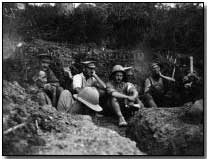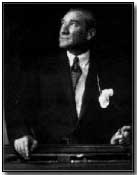Battles - The Battle of Sari Bair, 1915
 The Battle of Sari Bair
(also known as the Battle of the Nek),
launched on 6 August 1915, was timed to coincide with a further major Allied
landing of troop reinforcements at Suvla Bay on the Aegean coastline north
of Anzac Cove. The battle formed part of Allied Mediterranean
Commander-in-Chief
Sir Ian
Hamilton's three-plank Suvla Offensive.
The Battle of Sari Bair
(also known as the Battle of the Nek),
launched on 6 August 1915, was timed to coincide with a further major Allied
landing of troop reinforcements at Suvla Bay on the Aegean coastline north
of Anzac Cove. The battle formed part of Allied Mediterranean
Commander-in-Chief
Sir Ian
Hamilton's three-plank Suvla Offensive.
Aside from the landings at Suvla Bay intended with the aim of securing the Anafarta Hills, a secondary although critical attack from Anzac Cove was planned northwards to seize control of the Sari Bair ridge.
Dual Attack Importance
Success at both Suvla Bay and against Sari Bair was crucial if the Allies were to gain complete control of the central heights of the peninsular. From there the southern peninsular could be cut off and command of the Dardanelles Straits ensured, the Allies principal aim in the region.
The third plank of Hamilton's offensive anticipated a holding attack from Helles intended to pin Turkish forces in the southern peninsular, preventing them from rushing northwards to assist in repelling the Suvla landings.
British Anzac commander William Birdwood had contemplated a move north to the commanding Sari Bair ridge north-east of Anzac Cove since May but had been prevented from doing so by Hamilton's (reasonable) insistence that insufficient Allied resources were available to support the move, particularly given the arrival of Turkish reinforcements to the sector.
 However
with the promise of three fresh divisions (later expanded to five) courtesy
of the British war minister
Lord Kitchener,
Hamilton resuscitated Birdwood's plan as part of the wider Suvla Offensive.
However
with the promise of three fresh divisions (later expanded to five) courtesy
of the British war minister
Lord Kitchener,
Hamilton resuscitated Birdwood's plan as part of the wider Suvla Offensive.
Sari Bair Plan
Thus the new plan required the movement of two Anzac brigades northwards along the Aegean coast from Anzac Cove, which would then swing east towards the west flank and rear of Sari Bair. Quite aside from the inherent benefits in controlling the ridge - it offered a panoramic view of the surrounding area - its falling into Allied hands would prevent its use by the Turks in preventing the landings at Suvla Bay.
Consequently some 25,000 troops were added to Birdwood's Australian and New Zealand Corps, more than doubling its total to approximately 45,000. An advance from Anzac along the Aegean coast was initiated during the early hours of 6 August by General Godfrey and 22,000 troops, although advance reconnaissance was made difficult through highly effective Turkish sniping.
Allied Setbacks
In spite of the crucial requirement for speedy progress, the advance northwards hit immediate delays amid the maze of ridges, gullies and stiff heat accompanying the operation. The effects of ongoing dysentery also exacted its toll upon Godfrey's men. Consequently his force (which included future Anzac corps commander Sir John Monash) found themselves disastrously short of their first day's objectives - Chunuk Bair ridge and Hill Q - by close of daylight.
Meanwhile a heavy diversionary attack launched from Anzac Cove south towards Lone Pine the same evening resulted in heavy fighting which continued throughout the following day, 7 August, with a number of Turkish trenches falling into Allied hands on 8 August. Seven Victoria Crosses were awarded to the Anzac force as a consequence of hand-to-hand fighting at Lone Pine.
Unfortunately for the Allies the attack upon Line Pine proved far less diversionary than intended, for the Turkish reserves drafted in to defend Lone Pine were subsequently better placed to rush to the Sari Bair range once its importance became clearer.
 At
the same a further supporting operation southwest of Chunuk Bair (the Nek)
ended in failure faced with heavy artillery and smalls arms fire against
heavily fortified trenches.
At
the same a further supporting operation southwest of Chunuk Bair (the Nek)
ended in failure faced with heavy artillery and smalls arms fire against
heavily fortified trenches.
Hamilton had meanwhile made it clear that if necessary the fresh divisions newly-arrived at Suvla Bay were to come to Birdwood's aid in capturing Sari Bair as necessary. However Suvla commander Sir Frederick Stopford's ongoing policy of agonised procrastination left Birdwood waiting in vain for supporting troops. He therefore determined to push onwards towards Sari Bair on 8 August without Stopford's aid.
One of Birdwood's New Zealand brigades consequently managed to seize possession of the crest of Chunuk Bair as its Turkish defenders withdrew, but were subsequently obliged to abandon the position two days later under Turkish artillery bombardment.
Also faring badly was the single Gurkha battalion who attempted to capture Hill Q from the west without the aid of reinforcements. Having forced the Turks off the crest of the Hill they were themselves forced to withdraw following a mistaken Allied naval artillery bombardment.
 Meanwhile
local Turkish commander
Mustafa Kemal
(later known as Ataturk - 'Father of the Turks') poured in reinforcements,
with the result that two heavy counter-attacks were launched from the
commanding height of Chunuk Bair on 10 August.
Meanwhile
local Turkish commander
Mustafa Kemal
(later known as Ataturk - 'Father of the Turks') poured in reinforcements,
with the result that two heavy counter-attacks were launched from the
commanding height of Chunuk Bair on 10 August.
As a consequence the Allied Gurkha positioned was effectively demolished near Hill Q at 'The Farm' while the New Zealanders managed to hold out - barely.
Allied Failure
The Allied operation at Sari Bair had depended most crucially upon a rapid advance to the Sari Bair ridge in order that Allied troops could consolidate their position upon the ridge's summits. In the event they were denied the opportunity following a series of confused delays, an overall lack of command co-ordination together with the absence of assistance from Stopford's IX Corps at Suvla Bay.
The End of Fighting
Fighting petered out at the close of 10 August with both sides suffering from exhaustion. The undisputed victors however were Kemal's Turkish force. While his troops suffered a heavier burden of casualties - somewhere between 9,000-20,000 as opposed to Birdwood's 12,000 - the latter had not achieved any of his stated aims. Furthermore the failure of the operation brought to an effective end Allied plans to break out of Anzac Cove.
Hamilton's next objective was to be the linking up of Allied forces at Suvla Bay with those sited at Anzac, a distance of some 5km, and resulted in the Battles of Scimitar Hill and Hill 60.
Click here to read Lord Kitchener's report on the battle. Click here to read Sir Ian Hamilton's report. Click here to read the newspaper account filed by journalist Ellis Ashmead-Bartlett. Click here to read a summary of the battle by a German aide to German commander Liman von Sanders.
To view maps detailing the progress of the Gallipoli campaign click here; and here; and here; and here.
To view maps detailing the progress of the Gallipoli campaign click here; and here; and here; and here.
Photographs courtesy of Photos of the Great War website
By 1918 the percentage of women to men working in Britain had risen to 37% from 24% at the start of the war.
- Did you know?
